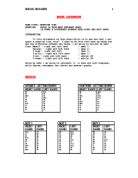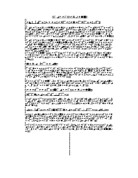- 20 – (3.34 + 3.34) = 13.32
(13.32 x 13.32) x 3.34 592.590 cm3
- 20 – (3.35 + 3.35) = 13.30
(13.3 x 13.3) x 3.35 592.581 cm3
From the table of 2 decimal places, I can see that the cut out of 3.33 has the largest volume at 592.592cm3.
To investigate even further, I will look at 3 decimal places and compare my results.
- Trial and Improvement to three decimal places:
- 20 – (3.331 + 3.331) = 13.338
(13.338 x 13.338) x 3.331 592.59237 cm3
- 20 – (3.332 + 3.332) = 13.336
(13.336 x 13.336) x 3.332 592.59252 cm3
- 20 – (3.333 + 3.333) = 13.334
(13.334 x 13.334) x 3.333 592.59258 cm3
- 20 – (3.334 + 3.334) = 13.332
(13.332 x 13.332) x 3.334 592.59257 cm3
- 20 – (3.335 + 3.335) = 13.33
(13.33 x 13.33) x 3.335 592.59248 cm2
I can see again that the cut out of 3.333cm has the largest volume of 592.59258cm3. For my final trial and improvement table I will look at 4 decimal places.
Trial and Improvement to four decimal places:
- 20 – (3.3331 + 3.3331) = 13.3338
(13.3338 x 13.3338) x 3.3331 592.5925904 cm3
- 20 – (3.3332 + 3.3332) = 13.3336
(13.3336 x 13.3336) x 3.3332 592.5925919 cm3
- 20 – (3.3333 + 3.3333) = 13.3334
(13.3334 x 13.3334) x 3.3333 592.5925925 cm3
- 20 – (3.3334 + 3.3334) = 13.3332
(13.3332 x 13.3332) x 3.3334 592.5925924 cm3
- 20 – (3.3335 + 3.3335) = 13.3330
(13.3330 x 13.3330) x 3.3335 592.5925915 cm3
From all my trial and improvement tables I can see that the largest box is one with a 3cm cut out. I will now plot these results on a graph looking at the range of 3.3331 – 3.3335cm cut outs.
The graph shows that the cut out of 3.3333cm is the best cut out to achieve the largest possible volume for the box.
I will now look to see if there is a link between the first 20 x 20cm square and the 3.3333cm cut out. I will see how many 3.3333’s are in 20cm.
20 ÷ 3.3333 = 6.000060001
This shows that it is 1 of 20.
6
So to get the maximum volume, I would cut out 1 from each corner of the square.
6
I will now test my theory on a different size square. I will choose a square 18cm x 18cm to investigate further.
To make life easier for myself, I will use the computer program, “Microsoft Excel” to produce my trial and improvement tables. In the spreadsheet program, I will input formulas into the boxes, which the computer can use to work out the length of the box. The volume can be worked out, given the length x width x height.
From the above trial and improvement table, I can see that a 3cm cut out from each corner, produces a box with the biggest volume. I will now investigate further by looking at cut outs between 2.5cm and 3.5cm.
One Decimal Place:
Once again, I can see that a cut out of exactly 3cm gives the largest size for a box sized 18cm x 18cm. I will now investigate further by looking at cut outs between 2.8cm and 3.2cm to 2 decimal places.
Two Decimal Places:
Looking at a table with cut outs to 2 decimal places, a cut out of 3.0cm still gives the best volume for a box. To finally investigate if one sixth is the largest cut out of the original shape, I will look at cut outs to 3 decimal places.
Finally, I can come to the conclusion that 3cm is the best cut out for a net shape 18cm x 18cm.
To finally check that the largest volume for the box is 1 of its original size, I will divide 18 by 3. 6
18 ÷ 3 = 6
This shows that 3cm cut outs are also 1 of the original size and are too, the largest volume possible. 6
1 of 18 is 18 ÷ 6 = 3cm
6
From my graph, I can now conclude that the biggest volume for a box would be to cut out one sixth off each corner.
To prove my findings further, I will take another box, sized 32cm x 32cm.
The above shows that 5cm cut outs will yield a box with the largest volume. I will now look at cut outs to one decimal place.
One Decimal Place:
Looking at the trial and improvement table to one decimal place, a cut out of 5.3cm gives the largest volume. I will now produce another trial and improvement table to 2 decimal places.
Two Decimal Places:
From the above table, a cut out of 5.33cm yields the biggest volume for a box. I will finally look at a trial and improvement table with cut outs to three decimal places.
Three Decimal Places:
To finally check if 5.333cm is also one sixth of the original net size, I will divide 32 by 5.333.
32 ÷ 5.333 = 6.0003
I will now prove my findings using algebra. Let ‘x’ be the size of the square cut out.
I will now multiply the equation “4x2 – 80x + 400” by x, to get the volume of the box formula in algebra.
4x2 – 80x + 400 multiplied by ‘x’ 4x3 – 80x2 + 400x
4x3 – 80x2 + 400x
I will now look at differentiation to prove the largest volume possible for the box:
Differential calculus is the area of mathematics concerned with the rate at which things change. For example, the speed of a car is the rate at which the distance it travels changes with time.
To find the maximum volume using algebraic theory, I will look at turning points. I have read that the maximum volume is when the turning point is at a gradient of zero, as shown in the example diagram below.
Cut Out (cm)
The point at which the tangent intersects the graph is where the gradient is equal to zero, as the tangent is parallel to the x axis. This indicates that the largest volume possible is at this point, as the curve reaches ‘the top of the hill.’ This process is called ‘differentiation.’
V = 4x3 – 80x2 + 400x
V = 4x33-1 – 80x22-1 + 400x11-1
V = 12x2 – 160x + 400
I now have the algebraic formula for finding the biggest volume of a box ‘X’ cm by ‘X’ cm. I will now differentiate. I am going to find the dv for the equation “4x3 – 80x2 + 400x.” dx
V = 4x – 80x + 400x dv = 4 x 3x3-1 – 80 x 2x2-1 + 400 x 1x1-1 dx
dv = 12x – 160x + 400 dv = 0
dx dx
Now that I have differentiated the equation, I will simplify it by cancelling everything down, by dividing by 4.
12x2 – 160x + 400 Divide by 4 3x2 – 40x + 100
3x2 – 40x + 100
I have now simplified the equation, finally, I will solve it.
3x2 – 40x + 100
(3x – 10) (x – 10)
(3x – 10) = 0 or (x – 10) = 0
3x = 10 x = 10
x = 10/3
x = 3 1/3
x = 3.33333
- To further my findings, I will create a square sheet sized ‘x’ cm by ‘x’ cm; to generate a general equation for the volume of this box:
V = (6x – x - x )2 × x V = 4x × 4x × x V = 16x3
6 6 6 6 6 6 6 216
I will now cancel my formula; V = 16x3 down to simplify it.
216
V = 16x3 V = 2x3
216 27
I will now show that my formula works, by entering in the size of the sides from my other square boxes. If the resulting figure is that of the largest cut out, I know that my investigations have been proved correct.
For 20cm x 20cm:
V = 2x3 V = 2 × (203) V = 16000 V = 592.592...cm3
27 27 27
This proves that a sixth cut out from each corner of any box will; result in the largest volume when the box is made. I will now show that the above formula also works for the other boxes that I have investigated.
For 18cm x 18cm:
V = 2x3 V = 2 × (183) V = 11664 V = 432cm3
27 27 27
For 32cm x 32cm:
V = 2x3 V = 2 × (323) V = 65536 V = 2427.2592cm3
27 27 27
Using this equation, I can find out the largest volume for any given square box. My above findings in the trial and improvement tables have been proved correct using algebra; and that a cut out of one sixth of the side length for any square box gives the largest volume possible.
Now that I have investigated the largest volume for a square, I will now do the same for a rectangle, sized 20cm by 15cm. I will analyze the results to see if there is any pattern, as before.
- Trial & Improvement to one decimal place:
From my trial and improvement table, I can see that a cut out of 3cm yields a box with the largest volume possible. I will now investigate further, by looking at a cut out of between 2.5cm and 3.5cm:
- Trial & Improvement – 2.5cm to 3.5cm:
From my results table, I can see that the volume was at its greatest with 2.8cm cut outs. I did not carry on the trial and improvement past 2.9cm cut outs, because the volume started to decrease again.
I will now look at the 2.8cm cut out to 2 decimal places:
- Trial & Improvement to 2 decimal places:
I can see from my trial and improvement, that a cut out of 2.83cm yields a box with the largest size. I will now create a formula for the box; ‘Y’ x ‘Z’ x ‘X’ and see what value I get for ‘x’.
I will now create my formula for the largest volume of the rectangle.
V = (20 – 2z) (15 – 2z) z
V = (300 – 40z – 30z + 4z2) z V = (4z2 – 70z + 300)z
V = 4z3 – 70z2 + 300z
I will now differentiate the above equation to find the dv
dx
= 4z × 33-1 – 70z × 22-1 + 300z × 11-1 = 12z2 – 140z + 300
At the turning point, the gradient is zero, so dy = 0. So substituting into my formula, gives: dx
12z2 – 140z + 300 = 0 3z2 – 35z + 75 = 0
-
I will now use the ‘Quadratic Formula’ to get 2 values for ‘x’
ax2 + bx + c
V = 3z2 – 35z + 75 (a = 3, b = -35 & C = 75)
V = 8.83 or V = 2.83
This proves that the largest volume for the rectangular box would come from a cut out of 2.83cm from each corner. Now that I have the equation: (20 – 2z)(15 – 2z)z I can substitute ‘x’ and ‘y’ into it to get a general formula for the biggest volume.
V = (x – 2z) (y – 2z) z
V = (4z2 – 2zx – 2zy - xy) z
V = 4z3 – 2z2x – 2z2y – xyz
V = 4z3 – 2z2(x + y) + 2xy
V = 4z3 – (x + y) 2z2 + xyz
= 4 × 33-1 – (x + y) 2 × 22-1 + xy × 1z1-1
= 12z2 – (x + y) 4z + xyz0
= 12z2 – (x + y) 4z + xy








